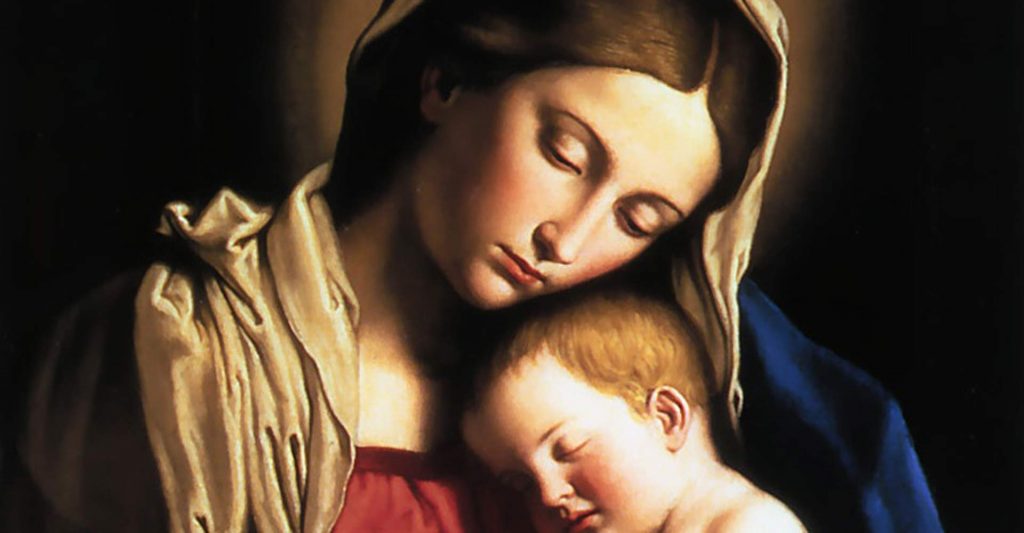
Walking with Mary in her joy and sorrow is part of the Christian life. Mary’s response to the many difficulties she faced in raising her son, Jesus Christ, shows us the way forward. She goes before us, reminding us that there is always—always—cause for joy.
By Sr.Christina M. Neumann
18 October 2019
As we just recently honored “Our Lady of Sorrows” in September, and are now in the month of our Lady of the Rosary, I thought it appropriate to reflect on Our Lady’s sorrows (and joys) and how they relate to us in our life.
Traditionally, Our Lady’s seven sorrows are: the prophecy of Simeon, the flight into Egypt, the loss of the Child Jesus in the temple, the meeting of Jesus and Mary on the Way of the Cross, the Crucifixion, the taking down of the Body of Jesus from the Cross, and the burial of Jesus. What is interesting about each of these sorrows is that there is joy found not far from each one—joy in Christ’s presence and joy in relationship with him.
Read about how Mary goes before us in the order of grace.
The prophesy of Simeon, that a sword of sorrow would pierce Mary’s own soul, was only a part of the joy-filled encounter in the temple. When Mary and Joseph brought the less than two month-old baby to Jerusalem, there was joy for them in having him with them, and joy for Simeon and Anna in seeing “the salvation prepared in the sight of every people.”
Even in the flight into Egypt, which has no immediate joy, they still had the Child Jesus with them. Knowing they were safe from the threat to his life would have been a relief too, if not a joy. The third sorrow of the “loss of the Child Jesus in the temple” was soon accompanied by the great joy of finding him again.
As we fast-forward to the meeting of Jesus and Mary on the Way of the Cross, we might reflect on the joy and peace found in being with someone you love. In Mary’s case, this meant being with someone she loved with all her heart! Although the scene was flooded with sorrow, wouldn’t there be a faint glimmer of joy in this meeting?
With the final two sorrows, I am reminded of the sermon of St. Bernard of Clairvaux which states: “Perhaps someone will say: ‘Had she not known before that he would not die?’ Undoubtedly. ‘Did she not expect him to rise again at once?’ Surely. ‘And still she grieved over her crucified Son?’ Intensely.”
I do not intend to diminish the intense sorrow of our Blessed Mother. To see the one you love who is so good and deserving of love be tortured and killed before your eyes—and furthermore, to be his mother—could possibly be the greatest known sorrow by any human person. It is no wonder we honor Mary under the title of Our Lady of Sorrows and sing the Stabet Mater, a hymn honoring her presence at the passion, every time we attend the Stations of the Cross during Lent.
Nonetheless, in all of this, Mary had hope; she had love. Would not these virtues also have brought some small sense of joy as well?
Although it is not found in scripture, there is a tradition that Mary was the first to see the Christ after his resurrection. She was the first missionary, bringing her unborn child to her relative Elizabeth.
Mary, our Mother, is an example to each of us. When we feel overwhelmed with sorrow, we can turn to her, remembering the intense suffering she went through. We also should remember the joy she found in her relationship with Christ. We, too, can find joy amidst sorrow in our relationship with him.
There is good reason that our Franciscan Rule exhorts us, “Let the brothers and sisters keep the example of the Blessed Virgin Mary, the Mother of God and of our Lord Jesus Christ, ever before their eyes.”
Mary’s obedient “yes” through joy and sorrow is a daily inspiration to each of us.As Franciscans, we have a special devotion to the joys of Mary too, which are meditated upon while praying “The Franciscan Crown” (comparable to a rosary with seven decades). This, however, would be the topic for another article.

Sr. Christina serves at St. Anne’s Living Center, a home for the elderly and disabled in Grand Forks, North Dakota. She also manages the web page for the facility, writes their weekly blog, and edits their resident newsletter. Sr. Christina also authors “Our Franciscan Fiat” , the blog for her religious community of Dillingen Franciscan Sisters in North Dakota. Before entering religious life, she received a bachelor of arts in written communication, with some coursework also in graphic arts and theology.
Leave a Reply